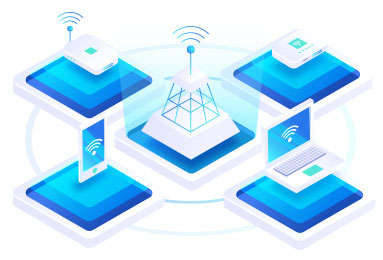What is a Point to Point Wireless Bridge?

What is a Point to Point Wireless Bridge?
A point to point wireless bridge is a type of technology that is used in Wi-Fi networking that allows users to connect multiple locations together. As such, two or more locations are able to use a point-to-point wireless bridge in order to share a single internet connection, which can allow them to share data across that shared network. Point-to-point wireless bridges are built between different wireless access points (also known as APs) in order to connect multiple local area networks (or LANs) for short. They have some differences from the multipoint wireless bridge.
P2P bridges are commonly used in industrial settings where network connectivity is needed between large numbers of devices. They also provide a cost-effective solution for connecting remote locations such as warehouses, factories, and construction sites.
If you’re looking for a simple way to extend your existing wired network into the garage, basement, or attic, then a P2P bridge may be just what you need. If you have any questions about how to set up one of these devices.
How Does it Work?
Point to point wireless bridges work by connecting two access points using either optical lasers or radio waves. As the name implies, there is no need for wires, cables, or poles to connect them. These connections are usually achieved by installing an antenna or radio device to the access point (which can include all manner of digital devices including computers, routers, sensors, cameras, and other devices).
These devices get linked to your own internal cabled infrastructure, establishing the wireless bridge that lends the term its name. The wireless bridge then acts as the client which maintains the connection with the primary router. The internet connection is then passed through this bridge to the other devices that are connected via LAN jacks.
Why do We Need This Kind of Technology in Our Daily Life?
Given how many devices we use to connect wireless to the internet, it should be no surprise that point to point wireless bridges are used very widely and for a large variety of different applications. They can be used to connect all manner of devices and locations together on the same network, usually in accessing high bandwidth and high-speed internet connections.
Point to point wireless bridges can be used to link multiple buildings together, connecting them to a single internet connection source and forming LANs over large distances and even through some obstacles. They are also used to connect things like CCTV camera systems, sensors, and a wide range of other devices to the same connection. Anything that can connect wirelessly can access a point to point wireless bridge.

Point to Point Wireless Bridge vs Point to Multipoint Wireless Bridge
In order to compare a point to point wireless bridges to a point to multipoint wireless bridge, we first have to define what the latter is. Point to multipoint wireless bridges connect multiple access points together through a single base station unit. The other points that connect to it are known as subscriber units. Base station units are often able to handle over 100 subscriber units and are widely used for large environments that need to be connected to a single internet connection, such as campuses.
Multipoint wireless bridges are typically used for a larger amount of connections with lower bandwidth needs. Point-to-point wireless bridges, on the other hand, are better for higher bandwidth demand but on fewer access points.
Why Use Point-To-Point Bridges?
There are several reasons why you might choose to use a point-to-point bridge rather than a router:
- Cost – Because point-to-point bridges do not require an access point, they’re much cheaper than routers. In fact, many manufacturers offer free models that only cost $10-$20.
- Security – Routers typically store all user information and pass it along to anyone who requests it. This makes them vulnerable to hacking attacks. With point-to-point systems, there’s no centralized database to hack.
- Speed – Since point-to-point devices do not rely on a central server to handle routing, they operate more quickly than routers.
- Ease Of Setup – Setting up a point-to-point bridge is easier than setting up a router because it requires less configuration.
Point-To-Point vs. Wired Bridging
You may wonder whether point-to-point is better than wired bridging. After all, isn’t a point-to-pointer basically a switch? Yes, but it also offers some advantages over standard switches. For example, point-to-point allows you to create multiple connections simultaneously. This is impossible with a regular switch.
Additionally, since point-to-point uses a dedicated link between the two computers, it provides a higher level of security than a regular switch.
What are the Advantages of Using a Wireless Bridge?
Using a wireless bridge, be it point to point or point to multipoint, allows you to connect devices to a shared network over a great distance. As such, it can be used to ensure fast and efficient data transfer in a remote location and to make sure that all networked devices follow the same rules of data sharing and access.
What are the Different Types of Wireless Bridges?
There are, largely speaking, two kinds of wireless bridges most commonly used. These are the point to point wireless bridges that allow two networks in two separate locations to connect to one another and a point to multipoint bridge that allows several subscriber units to connect to one base station unit. They both allow locations to form a network over distance but differ on how many locations they can connect to and what needs they can meet.
What are the Benefits of a Point-to-Point Wireless Bridge?
Point to point wireless bridges may be limited in that they can only connect two access points but, in return, they bring a range of specific advantages. They’re very easy to install, since devices need to be installed in only two locations, and are quicker and more cost-effective than building or leasing a fiber line. They’re very dependable connections, suitable for high bandwidth use, and offer lightning-fast connections. Given that they only connect two locations, they’re fairly easy to manage and to monitor, as well.
Summary
There are many different types of Wireless Bridges technologies available today with varying capabilities, costs and requirements. It’s important to understand what your needs are before choosing one. If you want high speed internet then look no further than Laser based solutions but remember that even though they are cheap they still cost money to install and maintain.
Why Choose ExterNetworks?
The company is based out of New York City but also serves clients from around the world. The team at ExterNetworks consists of more than 100 professionals who are dedicated towards providing quality support for their clients. They have been serving businesses since 2001 and they provide managed IT services such as cloud computing, data backup, security monitoring, remote access, email hosting, web development, VoIP phone systems, etc. Their goal is to help companies achieve success by offering them high-quality products and services
to Contact Us




